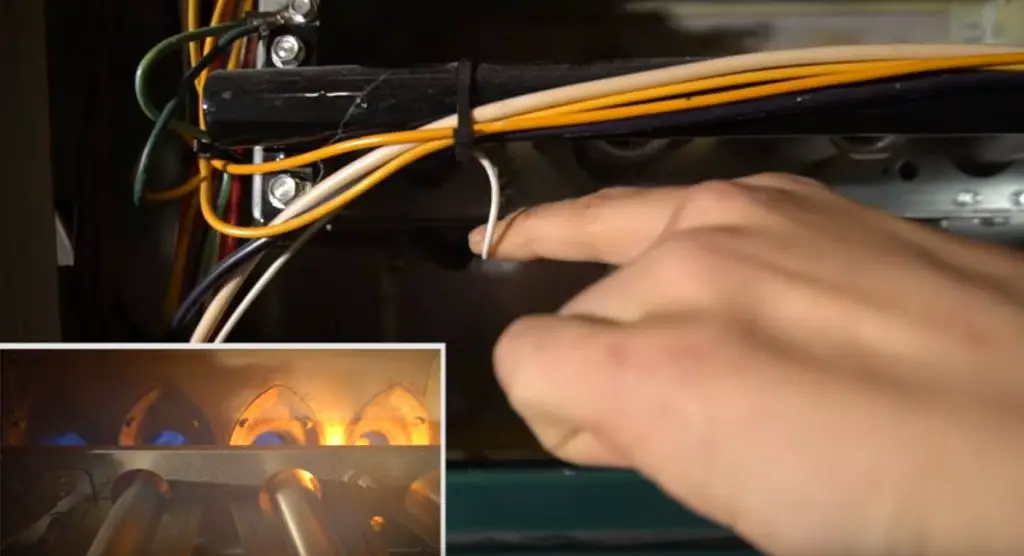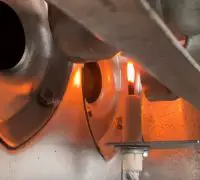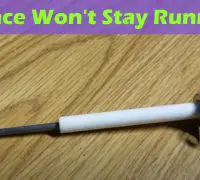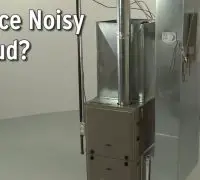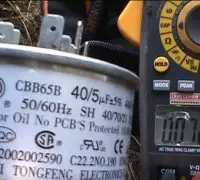Furnaces are the top choice for people in America to heat their homes. Even if these appliances are quite the power horses for heating, the risk of them developing issues is never null. If your furnace fires up but doesn’t stay on, you need to asses the situation immediately. The furnace cannot reach the desired temperature and you don’t want the whole winter to kick in with you in a cold house.
Page Table of Contents
- Why won’t the furnace stay on?
- The furnace is overheated
- The furnace is old
- The flame sensor is dirty
- The thermostat isn’t performing properly
- The igniter/Pilot Light is defective
- The blower motor doesn’t run
- The draft inducer motor is faulty
- The thermocouple is broken or defective
- The furnace’s condensate pan is full
- The fan limiter has failed
- The circuit /control board is faulty
- The furnace is the wrong size
- It’s extremely cold outside
- Final thoughts
Why won’t the furnace stay on?
A dirty flame sensor, a defective igniter, or a malfunctioning thermostat are reasons why a furnace doesn’t stay on. Even if some of your furnace’s problems don’t require professional assistance, some will need attention from certified technicians. It would help if you didn’t troubleshoot a short-circuiting furnace that doesn’t stay on. Contact a reliable HVAC technician to manage the furnace.
Here’s a helpful video detailing the most common causes:
Until you call the pros, you could, at least, understand why your furnace won’t stay on.
The furnace is overheated
An overheated exchanger could make a furnace not stay lit. It also means that the airflow into the heat exchanger is limited and there are several reasons for that:
- The air filter is dirty, so the blower cannot take enough air over the heat exchanger
- The air supply vents are closed, slowing down the blower and reducing airflow
- The blower wheel is dirty, slowed down, and restricts airflow.
When the furnace overheats, its safety features (high limit switch) will trip and turn it off to protect against further damage.
The fix
Unblocking blocked vents and cleaning a dirty air filter are straightforward jobs, but you cannot postpone fixing an overheated furnace. If the safety features are defective, the overheating furnace won’t shut down, and a fire could start.
The best way to manage an overheating furnace is to contact a certified HVAC technician immediately. It’s not a problem to troubleshoot on your own.
The furnace is old
Even if furnaces have a good lifespan, they need replacement at some point. As a furnace age, it will become less effective and more expensive. Additionally, it will show various signs of wear, such as burners not staying lit.
The fix
If your furnace is old and dysfunctional, the only solution is to replace it with a new one. According to the U.S. Department of Energy, furnaces 20 years and older should be replaced even if they are still functional. After you return the old furnace with a new one, the energy bills will decrease as new models are highly energy efficient.
The flame sensor is dirty
A dirty flame sensor rod could be the issue when the furnace turns on several times and only stays lit for a few seconds. Every time the furnace flame sensor doesn’t identify the flame, it will shut off the gas valve (it’s for safety reasons). A flame sensor that shuts off the gas valve if it doesn’t detect a flame prevents gas poisoning and explosion.
Sometimes, the flame sensor is covered with soot, and it’s unable to identify the flame. It’s a problem that needs assistance right away.
The fix
The dirty flame sensor needs cleaning. Here’s how you can do it:
- Turn off the furnace
- Access the sensor by opening the combustion chamber panel door
- Remove the sensor
- Use an emery cloth, some steel wool, or a piece of light-grit sandpaper to remove dust, grit, or rust from the sensor
- Put the sensor back in its place
- Give the sensor a test
If cleaning the sensor doesn’t help, call an HVAC technician. The flame sensor might need replacement, so a professional should do it.
The thermostat isn’t performing properly
The thermostat commands the furnace to turn off when the desired temperature is achieved. It also tells it to turn on when the temperature goes down. If the thermostat is in a poor location and the temperature is higher than in the house, the thermostat won’t be effective. It will give the wrong signals to the furnace. As a result, the furnace will turn off before the desired temperature is achieved and turn on when the house is still warm.
The setting on the thermostat could be wrong. Not increasing the set temperatures when seasons change is one reason the furnace doesn’t operate as it should.
The fix
One easy fix is simply replacing the thermostat and seeing if the issue is solved. However, it might be the solution. We recommend you call an HVAC technician first to check out the thermostat. He will advise you on what to do next; maybe the thermostat only needs re-adjusting, not a replacement.
Take a look at the thermostat—maybe you forgot to change the temperature settings with the change of seasons. Increase the temperature and ask a family member to stay by the furnace. The furnace is good if it clicks and starts running after you increase the temperature.
The igniter/Pilot Light is defective
New furnace models come with a hot surface igniter, whereas old models feature a pilot light. The gas valve shuts off when the igniter doesn’t work properly or the pilot light goes out to prevent gas leaks. Therefore, the furnace won’t remain lit.
Several problems can happen to the furnace igniter:
- The old igniter is spoiled or worn out
- The temperature limiting switch is defective. It’s a safety feature that turns off the burners if the furnace is too hot.
- The igniter isn’t compatible with the furnace’s voltage, so it keeps failing.
- A power surge has burned the igniter (the risk is high with the hot surface igniters).
The fix
Contact the professionals if the furnace is on and doesn’t remain lit. When there are problems with the gas supply and the power, you should contact the professionals and avoid DIY troubleshooting.
The blower motor doesn’t run
The blower motor pushes warm air from the furnace into the vents and to your house. The furnace will turn off when it doesn’t operate correctly to prevent overheating the heat exchanger. The blower motor might not work for various reasons:
- It doesn’t receive power
- The fan relay is defective
- The blower motor belt is worn out
The fix
Repairing or replacing a defective blower motor is a job for the specialized furnace technician. He will discover the problem with the blower motor and decide if repair or replacement is the solution.
Don’t postpone managing a defective blower motor, as it can cause the overheating of the heat exchanger. Once the heat exchanger breaks down, the whole furnace will become dysfunctional.
The draft inducer motor is faulty
The draft inducer motor turns on for a minute and has to clear excess combustion gases from the previous cycle and vent them out from the house. As the burners turn on, the draft inducer motor will supply oxygen to the burners.
If the draft inducer operates correctly, the pressure switch (it measures how much air flows through the heat exchanger) will close. However, when the draft inducer motor is faulty, there will not be enough air circulating in the furnace. Therefore, the pressure switch won’t close and will turn off the furnace.
The fix
Not all furnaces come with a draft inducer motor, but many standards require new models to come with one. You should contact a certified HVAC technician if the inducer motor is defective. Draft inducer motors are tricky to repair and you should contact professionals.
The thermocouple is broken or defective
The thermocouple is a sensor that detects the pilot light. When the pilot light goes off, the thermocouple will shut off the gas valve to prevent accidents. When the furnace’s thermocouple doesn’t perform correctly, it might shut the gas valve erratically, making the burners not stay lit.
The fix
Only a specialized HVAC technician can tell if the thermocouple has malfunctioned and needs replacement. Contact one and don’t attempt troubleshooting a defective furnace thermocouple.
The furnace’s condensate pan is full
Condensing (high-efficiency) furnaces generate condensate that drips into a condensate pan. From there, it’s drained down a condensate pipe and into the primary drainage. When the drainage line is blocked, the condensate pan will fill up, and the evaporator coil sensor will identify high liquid levels. As a consequence, the furnace will shut off.
The fix
Start by draining the condensate pan with an absorbent duster before you unclog the drainage line. You can use a straight wire to pass and remove all debris that blocks the drainage line. A plumber’s snake is the recommended tool for the job. Use a mixture of hot water, vinegar, and some kitchen soap to soak and remove all soot and debris stuck to the drain pipe. You can find an algaecide treatment and pan cleaner (HVAC-safe) product for the best cleaning results.
A certified HVAC technician will do a better job than most people when it comes to furnace problems. He can also recommend the things to do to prevent condensate drain clogs.
The fan limiter has failed
The fan limiter is a device that detects when the furnace’s blower turns on and off. It monitors when the warm air goes through the vents inside the house and reduces the risk of the heat exchanger overheating. Thus, it prevents fires. When the fan limiter doesn’t operate correctly, it can make the furnace turn off too soon.
Several issues can make a fan limiter malfunction:
- The switch sensor is dirty
- The air filters are clogged, so the temperatures increase and make the switch trip too soon
- The blower motor overheats and the switch trips, making the furnace shut off
- Various problems with the contractors, thermostat, circuit board, or gas valve may also make the fan limit switch malfunction.
The fix
The furnace needs annual maintenance before you light it for the first time in the winter. The cleaning during maintenance will ensure proper operation of the fan limiter. If the fan limiter is already faulty, you need to contact a reliable HVAC technician, as repair or replacement is not a DIY job.
The circuit /control board is faulty
When you’ve gone through all the possible problems for your furnace not staying lit, a bad circuit board could be the cause. The furnace’s circuit board gives the HVAC components power when needed. When it’s defective, the furnace or any HVAC system component won’t get the necessary power, so that it won’t remain on.
Furnace circuit boards commonly feature an LED light that blinks whenever there’s a problem. If the furnace doesn’t stay on, look at the light to see if it’s blinking. Inside the panel lid, you should find a diagnostic chart informing you on what the warning light is signaling. Identifying the problem will give your HVAC technician an idea about what to expect when he comes for fixing.
The fix
If the furnace has problems with the power supply, you should contact a dependable HVAC technician. Don’t troubleshoot circuit board problems and get the expert for further assistance. Troubleshooting a control board is complicated and requires a pro’s expertise and a meter’s use.
The furnace is the wrong size
They say the bigger, the better, but the principle isn’t valid with furnaces. Even though a large furnace will generate more heat, it doesn’t mean the entire home will be heated the same way. On the contrary, the furnace will start short cycles to distribute the warm air inside the house evenly. When the warm air isn’t evenly spread, the furnace will get the signal to stop (doesn’t stay on) and start more often than it should.
The fix
If the furnace is too big for your home, you need to buy a smaller one. When you look for a furnace, you should know that a cooling and heating system has to give 12,000BTU of cooling or heating for every 400-500 square feet of your house. It’s a rule that doesn’t consider the climate and a house’s insulation.
We recommend you contact an HVAC technician before buying a furnace. He will use the Air Conditioning Contractors of America (ACCA) Manual J to identify the best size of furnace for your home.
It’s extremely cold outside
As you can see, sometimes it’s not a problem with the furnace. When the temperatures are extremely low, the furnace will turn on, but it won’t stay lit for the 15 minutes heating cycle (it’s cold cycling). It’s how the furnace deals with the freezing temperatures and the continuous on-off cycling makes it difficult for the system to reach the desired temperature. The house will be cold.
If the furnace is properly operating, cold cycling shouldn’t happen. Several factors weigh in and stop the furnace from staying lit when the temperatures are extreme:
- The home has poor insulation and loses heat through the windows, door, and the roof
- The house has high ceilings, so it takes time to heat
The fix
There aren’t many things that you can do when the weather is freezing. However, you should still check out the furnace to see if there aren’t underlying problems. If the house’s insulation is poor, you should manage the problem and run repairs and changes. Replacing single-pane windows with double-pane ones is one of the many things to improve the house’s insulation and furnace operation.
Final thoughts
Furnaces are supposed to work in 10-15 minutes cycles under normal circumstances. It would help if you looked into it when they run for a few minutes and don’t stay lit, as there are several causes. From freezing weather to defective igniters or thermostats, there are many reasons for a furnace’s inability to run a proper cycle. Most of the problems will require attention from the HVAC expert and we strongly recommend not postponing servicing.
